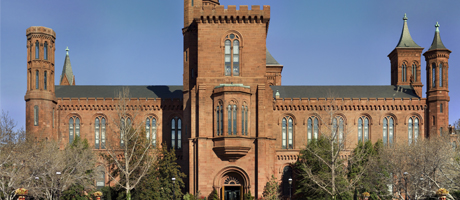Bee pollination of particular plants, fungal impact on mineral erosion and wood decay, and physical attributes of ray-finned fish all have something in common: They are being studied by Columbian College researchers in collaboration with experts from the Smithsonian.
For the second year in a row, the GW–Smithsonian Opportunity Fund is enabling scientists and scholars to come together on start-up projects using seed money provided jointly by the two institutions. Members of the GW community will have the opportunity to hear about these projects and more at the GW-Smithsonian Collaborative Research Symposium on February 21 in Phillips Hall, Room 209.
“This scientific interaction between GW faculty and Smithsonian experts continues a 100-year tradition of exchanges between the two institutions,” said Randall Packer, a Columbian College associate dean.
This year’s funded projects, described below, represent unique opportunities for scientific study among prominent researchers and invaluable learning experiences for students.
The Impact of Fungus on Minerals
Associate Professor of Chemistry and Geosciences Henry Teng and Cara Santelli, a biogeochemistry expert from the Smithsonian Institution, will perform cutting-edge environmental research focused on the impact of fungus on mineral erosion over time. They will also collect unique minerals to be added to the National Gem and Mineral Collection. Building upon the study’s findings, an interdisciplinary team of scientists and undergraduate and graduate students will research geomicrobiology in Maryland, China, and in GW and Smithsonian laboratories, providing students hands-on experience with an international scope.
The Genetics of Pollen
Associate Professor of Biological Sciences John Lill and several researchers from the Smithsonian’s Museum of Natural History will collect and study pollen harvested from bees to study the interaction between plants and the bees that pollinate them. The samples will be collected on Plummers Island in Maryland. David Erickson, a biologist from the Smithsonian’s Department of Botany, will lend his expertise in modern plant molecular genetics to the project. The undergraduate students involved in the project will have the unique opportunity to analyze pollination patterns at the Smithsonian’s Collections and Genetics Lab.
Studying Wood Decay
Assistant Professor of Biological Sciences Amy Zanne and graduate student Amy Milo, as well as Sean McMahon and Melissa McCormick from the Smithsonian Environmental Research Center, will be conducting novel research on forest ecology. Their work weaves together disparate threads of climate change, forest ecosystem carbon storage and turnover, and DNA sequencing of fungal genes to examine fungal influences on wood decay over time. Wood is the largest biological store of carbon and, in many systems, fungi are the main decomposers, breaking down the wood and releasing carbon back into the atmosphere. The team is working to discover which fungi decay wood, how quickly, and under what circumstances.
Examining the Evolution of Fish Diversity
Professor of Biological Sciences Guillermo Orti and Richard Vari from the Museum of Natural History’s Department of Vertebrate Zoology are working together to study fish diversity. They will focus on Characiformes, a highly diverse group of freshwater fishes found in Africa and South and Central America. Comprised of more than thousand species, the group’s most famous members are the piranhas. The researchers will combine expertise in morphology and anatomy with molecular genetics and genomics to put together a “family tree” for these fishes. Based on this genealogical perspective, they will address fundamental questions about where different types live and how they ended up on different continents, based on shifts of the Earth's land masses in ancient times. Also, the team plans to examine how Characiformes evolved into a vast array of creatures with starkly different physical characteristics.


